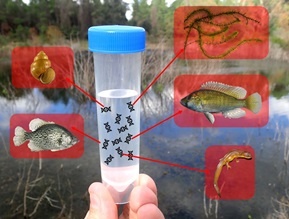Environmental DNA in the NAS Database
Environmental DNA (eDNA) comprises genetic material that has been sloughed, excreted, or otherwise released into the environment and can be detected in water, soil, and air. For aquatic organisms, this includes skin, excrement, mucus, saliva, blood, and gametes. Collection of environmental samples can be screened for the presence of eDNA, allowing for the detection of low-density organisms before detectability by traditional sampling methods.
NOTE: Environmental DNA detection data does not indicate the organism is present, only its genetic material, and is not a substitute for visually observing the organism’s presence.
Looking towards the needs of our partners NAS scientists, in collaboration with environmental DNA (eDNA) interagency experts, have used a consensus method for community data standards for integrating eDNA data into the NAS Database. The combination of traditional specimen sightings and eDNA detections can provide more complete species distribution records and significantly improve the ability to respond quickly to new invasions as part of an early detection rapid response (EDRR) system.
The goals of integrating eDNA into the NAS database include:
-
Establish, maintain, and update community data standards with the cutting edge of eDNA science;
-
Communicate with managers, scientists, and stakeholders to inform management decisions and responses while minimizing unnecessary responses;
-
Provide a public interface with vetted data to display eDNA detections in conjunction with observed and reported specimens.

We enlisted several researchers from USGS, the U.S. Fish and Wildlife Service, and the Bureau of Reclamation that focus on both eDNA and non-native species to serve as an advisory panel during the development of eDNA data sharing and submission standards. We worked with this advisory panel to identify the minimum required and desired optional data fields that would be necessary for effective communication of eDNA results. We hosted six virtual townhalls in 2020 to solicit input from our partners and prospective partners in state and federal natural resource management agencies on how NAS is integrating eDNA into the Database, what concerns they may have, and what interfaces and outputs would be most useful to them. This has included developing a communication plan to convey eDNA reports to affected managers, to allow them to decide how to proceed. Finally, we submitted our community standards through several rounds of review to include additional eDNA scientists at other federal, state, and academic institutions, culminating in a review by the Aquatic Nuisance Species Task Force members.
View eDNA data within the NAS Database
Submit eDNA data to the NAS Database
The NAS Database is currently accepting submissions of eDNA datasets. Information regarding the submission process and required information can be found at our Guidance Document.
Ready to submit data? Please click HERE to start the process.
This page is intended to serve as an informational hub for the development and integration of eDNA into the NAS Database. For more information or questions, please contact Matthew Neilson (mneilson@usgs.gov)